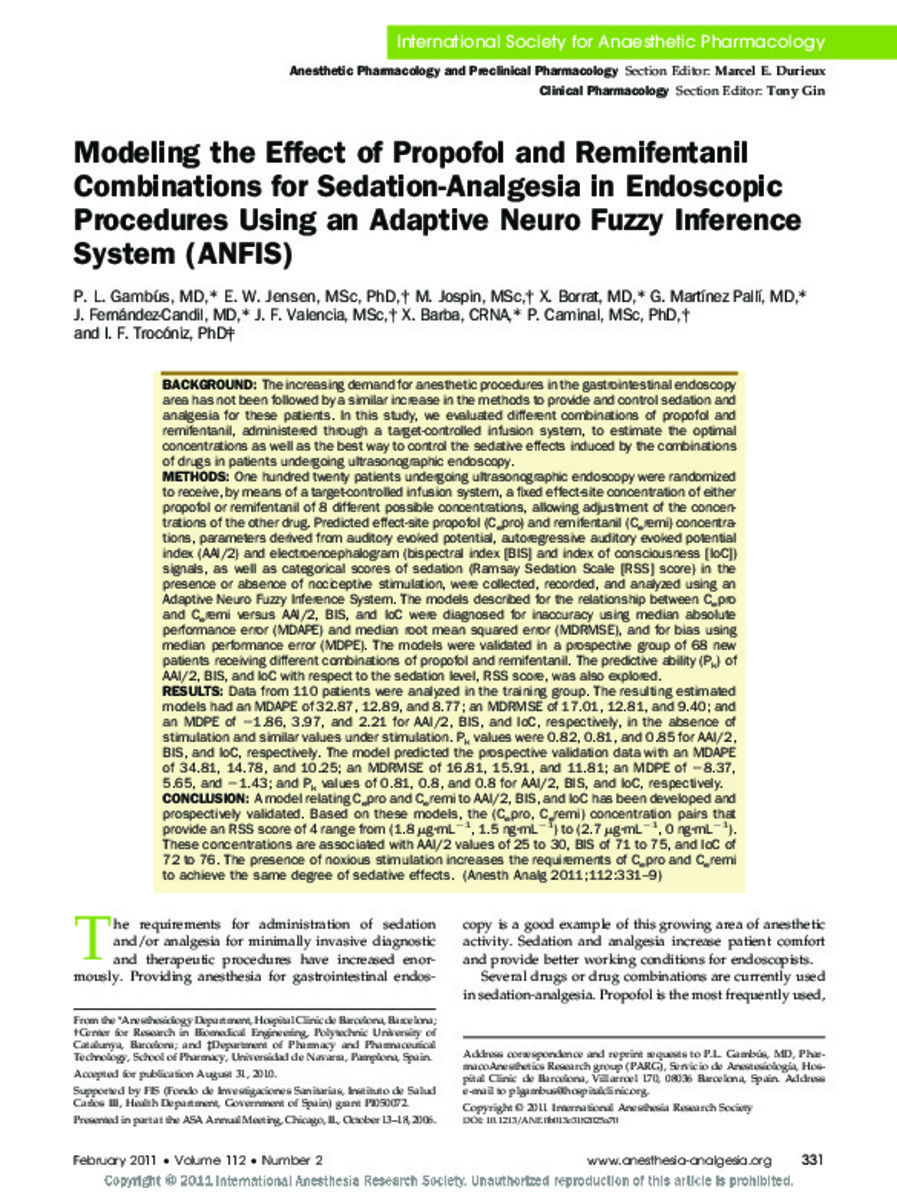Full metadata record
| DC Field | Value | Language |
|---|---|---|
| dc.creator | Gambús, P.L. (Pedro L.) | - |
| dc.creator | Jensen, E.W. (E. W.) | - |
| dc.creator | Jospin, M. (M.) | - |
| dc.creator | Borrat, X. (X.) | - |
| dc.creator | Martinez-Palli, G. (G.) | - |
| dc.creator | Fernandez-Candil, J. (J.) | - |
| dc.creator | Valencia, J.F. (J.F.) | - |
| dc.creator | Barba, X. (X.) | - |
| dc.creator | Caminal, P. (P.) | - |
| dc.creator | Troconiz, I.F. (Iñaki F.) | - |
| dc.date.accessioned | 2012-04-20T09:26:07Z | - |
| dc.date.available | 2012-04-20T09:26:07Z | - |
| dc.date.issued | 2011-02 | - |
| dc.identifier.citation | Gambús PL, Jensen EW, Jospin M, Borrat X, Martínez Pallí G, Fernández-Candil J, et al. Modeling the Effect of Propofol and Remifentanil Combinations for Sedation-Analgesia in Endoscopic Procedures Using an Adaptive Neuro Fuzzy Inference System (ANFIS). Anesth Analg. 2011 Feb;112(2):331-9. | es_ES |
| dc.identifier.issn | 0003-2999 | - |
| dc.identifier.uri | https://hdl.handle.net/10171/21701 | - |
| dc.description.abstract | BACKGROUND: The increasing demand for anesthetic procedures in the gastrointestinal endoscopy area has not been followed by a similar increase in the methods to provide and control sedation and analgesia for these patients. In this study, we evaluated different combinations of propofol and remifentanil, administered through a target-controlled infusion system, to estimate the optimal concentrations as well as the best way to control the sedative effects induced by the combinations of drugs in patients undergoing ultrasonographic endoscopy. METHODS: One hundred twenty patients undergoing ultrasonographic endoscopy were randomized to receive, by means of a target-controlled infusion system, a fixed effect-site concentration of either propofol or remifentanil of 8 different possible concentrations, allowing adjustment of the concentrations of the other drug. Predicted effect-site propofol (C(e)pro) and remifentanil (C(e)remi) concentrations, parameters derived from auditory evoked potential, autoregressive auditory evoked potential index (AAI/2) and electroencephalogram (bispectral index [BIS] and index of consciousness [IoC]) signals, as well as categorical scores of sedation (Ramsay Sedation Scale [RSS] score) in the presence or absence of nociceptive stimulation, were collected, recorded, and analyzed using an Adaptive Neuro Fuzzy Inference System. The models described for the relationship between C(e)pro and C(e)remi versus AAI/2, BIS, and IoC were diagnosed for inaccuracy using median absolute performance error (MDAPE) and median root mean squared error (MDRMSE), and for bias using median performance error (MDPE). The models were validated in a prospective group of 68 new patients receiving different combinations of propofol and remifentanil. The predictive ability (P(k)) of AAI/2, BIS, and IoC with respect to the sedation level, RSS score, was also explored. RESULTS: Data from 110 patients were analyzed in the training group. The resulting estimated models had an MDAPE of 32.87, 12.89, and 8.77; an MDRMSE of 17.01, 12.81, and 9.40; and an MDPE of -1.86, 3.97, and 2.21 for AAI/2, BIS, and IoC, respectively, in the absence of stimulation and similar values under stimulation. P(k) values were 0.82, 0.81, and 0.85 for AAI/2, BIS, and IoC, respectively. The model predicted the prospective validation data with an MDAPE of 34.81, 14.78, and 10.25; an MDRMSE of 16.81, 15.91, and 11.81; an MDPE of -8.37, 5.65, and -1.43; and P(k) values of 0.81, 0.8, and 0.8 for AAI/2, BIS, and IoC, respectively. CONCLUSION: A model relating C(e)pro and C(e)remi to AAI/2, BIS, and IoC has been developed and prospectively validated. Based on these models, the (C(e)pro, C(e)remi) concentration pairs that provide an RSS score of 4 range from (1.8 μg·mL(-1), 1.5 ng·mL(-1)) to (2.7 μg·mL(-1), 0 ng·mL(-1)). These concentrations are associated with AAI/2 values of 25 to 30, BIS of 71 to 75, and IoC of 72 to 76. The presence of noxious stimulation increases the requirements of C(e)pro and C(e)remi to achieve the same degree of sedative effects. | es_ES |
| dc.language.iso | eng | es_ES |
| dc.publisher | International Anesthesia Research Society | es_ES |
| dc.rights | info:eu-repo/semantics/openAccess | es_ES |
| dc.subject | Anesthetic procedures | es_ES |
| dc.subject | Gastrointestinal endoscopy | es_ES |
| dc.subject | Propofol and remifentanil | es_ES |
| dc.subject | Sedation | es_ES |
| dc.title | Modeling the Effect of Propofol and Remifentanil Combinations for Sedation-Analgesia in Endoscopic Procedures Using an Adaptive Neuro Fuzzy Inference System (ANFIS) | es_ES |
| dc.type | info:eu-repo/semantics/article | es_ES |
| dc.type.driver | info:eu-repo/semantics/article | es_ES |
| dc.identifier.doi | http://dx.doi.org/10.1213/ANE.0b013e3182025a70 | es_ES |
Files in This Item:
Statistics and impact
Items in Dadun are protected by copyright, with all rights reserved, unless otherwise indicated.






